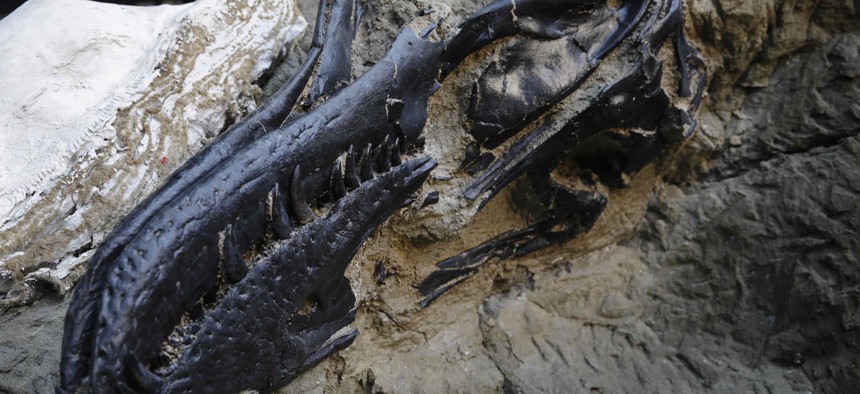Dinosaur Fossil Dispute to Get Attention From State Supreme Court

One of the two "dueling dinosaurs" photographed in New York in 2013. AP Photo/Seth Wenig
The Montana case involves competing claims about who owns the valuable remains. Is it surface land or mineral rights holders?
The two dinosaurs that appear to have been fighting with one another around 66 million years ago before ending up entombed in sandstone had no way of knowing that their remains would one day be central to a dispute of a different kind.
These “dueling dinosaurs,” as they are now known, are among the fossils unearthed on private land in Montana, in an area called Hell Creek. The discovery of the prehistoric remains led to a lawsuit in federal court that dates back to 2014.
In the case, the majority owners of mineral rights on the tract of land and the owners of the surface property are at odds over which of them can claim the fossils.
On Monday, the full, or “en banc,” 9th U.S. Circuit Court of Appeals issued a ruling asking Montana’s state Supreme Court to weigh in.
The court halted the federal court proceedings in the case and “certified” a question for the state’s high court to consider: “Whether, under Montana law, dinosaur fossils constitute ‘minerals’ for the purpose of a mineral reservation.”
This case recently drew attention from Montana lawmakers, prompting legislation.
On April 16, Gov. Steve Bullock, a Democrat, signed a law that says dinosaur “fossils are not minerals and that fossils belong to the surface estate,” unless there’s a clear agreement stating otherwise.
But this law does not affect court proceedings that were underway before the law takes effect.
And the 9th Circuit ruling notes that whether the state’s new fossil law applies retroactively has not been litigated.
Mary Ann and Lige Murray, who are on one side of the case and own the surface rights to the area where the fossils were found, and Clayton Phipps, who found the fossils, were among those who joined Bullock when he signed the law, the Associated Press reported.
The Murrays began leasing property in the 1980s in Garfield County, Montana from George Severson and worked there as ranchers.
Over the years that followed, according to court filings, Severson and his wife transferred parts of their interest in the land to their sons Jerry and Bo, and transferred and sold land to the Murrays.
In 2005, Jerry and Bo agreed to sell the Murrays all of their surface ownership rights.
But the Severson brothers also retained most of the mineral rights tied to the land. Separating mineral and surface ownership is not uncommon in places where there are deposits of oil or gas, or other materials that are valuable for mining.
In the months after the sale was completed, the Murrays say they became aware of a Pachycephalosaur “spike cluster” on the property, according to a court filing by the Seversons.
This was followed in 2006 by the discovery of the dueling dinosaurs—described as a 22-foot-long theropod, a group that includes a number of flesh-eating dinosaurs, and a 28-foot-long ceratopsian, a herbivore with a beak of sorts and a bony curved plate at the back of its head.
Later other fossils were excavated, including a fossilized Triceratops skull in 2011 and the remains of a Tyrannosaurus rex in 2013.
The Seversons attempted to claim an ownership stake in the fossils based on their mineral rights. But the Murrays sought a state court judgement that the fossils were part of the surface estate. The case moved to federal court, with the Seversons filing a counterclaim.
The fossils are thought to be worth millions of dollars. The T. Rex has already sold to a Dutch museum for several million, with some proceeds in escrow until the litigation is resolved, court filings say.
The Seversons interests are now held by two limited liability companies: BEJ Minerals and RTWF, which are named on their side of the court dispute. Attempts on Tuesday to reach three lawyers by email who have represented them were unsuccessful.
One of the Murrays’ lawyers did not return a phone message seeking comment.
The 9th Circuit order says Montana’s Supreme Court has not decided whether dinosaur fossils belong to the owner of a surface estate, or the mineral rights owner on a given tract of property.
A federal district court ruled in favor of the Murrays in 2016, deciding that the fossils are not covered by the ordinary definition of “mineral” and were therefore part of the surface property. A panel of 9th Circuit judges reversed that ruling. But the Murrays petitioned for an en banc rehearing that yielded this week’s ruling from the appeals court.
Under the certified question process that has now come into play in the case, federal courts can ask a state Supreme Court to answer a question that hinges on state law.
Montana’s high court can opt to accept, reject or modify the question.
Sidney Thomas, chief judge for the 9th Circuit, wrote in the order that the court elected to certify the fossil question to the state Supreme Court because of “the importance of the state law question, and the potential of different outcomes in federal and state courts.”
“Given the frequency of divided ownership of Montana surface and mineral estates, and that Montana possesses vast deposits of valuable vertebrate fossil specimens,” the judge added, “the issue is substantial and of broad application.”
Bill Lucia is a Senior Reporter for Route Fifty and is based in Olympia, Washington.
NEXT STORY: States Introduce New Laws to Keep Abused Women Out of Prison






